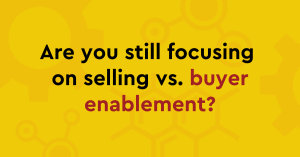
As it relates to B2B products and services, the buying process and individual buyer behavior have changed dramatically over the past couple of decades. Handshake deals with your golfing buddy have been replaced by buying committees spanning multiple business functions. Multi-million dollar, buy-it-all-now deals have been replaced by pilot projects and “try before you buy” scenarios. Referrals still carry a lot of weight, but those referrals merely get you into the consideration mix, followed by a comprehensive vetting process. And while superstar salespeople are as valuable as ever, buyers no longer want to speak to them; in fact 33 percent want a completely seller-free experience, and that number climbs to 44 percent with millennials. As millennials continue to take over the majority of B2B decision-maker spots in corporate America, the desire to deal with your salespeople will decline even more.
Instead, the salesperson’s job now largely focuses on buyer enablement. And the anchor to all buyer enablement efforts is buyer-centric, easy-to-consume, useful, and credible content.
How can your organization make the shift to today’s selling and master buyer enablement?
Nail your buyer personas to nail buyer enablement
According to Gartner, the typical buying group for a complex B2B solution involves six to 10 decision-makers, each armed with four or five pieces of information they’ve gathered independently and must deconflict with the group.
Does that mean you need to research and build six to 10 buyer personas? Of course not, but you do need to group the buyers and influencers into a few categories—based on function—and build personas for each.
For instance, in healthcare, each customer persona has distinct pain points and concerns, even though they share common goals. In that space, your actual buyer may be a CIO whose priorities are consolidation, standardization, and integration. But your financial buyer is the CFO, who is primarily concerned with the total cost of ownership and return on investment. And then you must consider the clinical buyer, who is looking for a systematized infrastructure and workflow efficiencies.
Once you have personas identified, you’ll need content that addresses their distinct pain points.
Create content in multiple formats
The majority of B2B buyers say they typically consume three to five pieces of content before engaging with a vendor. That doesn’t consider the content used after the buyer has engaged; some research studies estimate the total pieces of content consumed during the entire sales process to be an average of 13.
Making things more difficult to navigate is that within those 13 pieces of content, individual buyers exhibit individual format preferences. Some will read (or at least skim) longer-form material such as research reports or white papers. Others prefer to self-educate via videos or webinars. And still, others look for shorter-form social posts or articles/blog posts.
I’m not advocating for quantity over quality but given that buyers may not want to talk to you unless they absolutely have to, you need to have enough content on a variety of subjects and in different formats to satisfy the buyer’s need for research. Because if you can’t provide the answer and your competition can, guess who is going to get the sale?
If you are early in your content marketing efforts, my recommendation is to start with two to three types of content that sit at the intersection of what your audience wants and what your team feels comfortable creating, then repurpose that content into the less comfortable formats.
Write about solutions, not features
Your topic choices should focus on the buyer’s pain points vs. what your technology can do or its superiority over the competition’s very similar product. How will your solution solve the biggest problems your persona has? For instance:
- Can it show day-1 ROI to address the CFO’s concerns?
- Does it seamlessly integrate with existing technology and require very little training, improving workflow and simplifying adoption?
- Will it help generate revenue by easily creating efficiencies or organizing data?
As you narrow your topic list down, remember that with one subject — like how you show day-1 ROI —you can address the top of the funnel with an overview and then get deeper into the sales funnel with a detailed white paper and a case study that shows exactly how it worked for one of your clients.
Train your salespeople on how to use content
Once you have the content, how do you get your salespeople to use it? Raise your hand if you’ve been a part of this scenario.
Salesperson: I need a piece of collateral describing our value prop to the lice removal industry. And it must contain words like ROI, scale, and bleeding edge.
Marketing Director: We built a piece on that three years ago.
Salesperson: (After searching for 1 minute, 29 seconds) I can’t find it. Can you Slack it to me?
Marketing Director: Sure, here it is.
Salesperson: This is great, but it doesn’t contain the word “bleeding edge” and that’s super important to them.
Marketing Director: *Sigh*
Joking aside, versions of this conversation are happening inside thousands of corporate Slack channels as we speak. And I’ll explain exactly why: it’s either a lazy salesperson, a lazy marketer, both, or a content marketing strategy that does not include (and mandate) continuous training and exposure to new content and how to use it.
Here’s how exceptional content marketers ensure their sales teams maximize their use of content:
- They involve a sales leader (at a bare minimum) in the content strategy and planning process.
- They meet regularly with the sales team to “pitch” the content that is available to them, as well as to ideate future content ideas.
- They celebrate (publicly) salespeople who are using content to their advantage.
- They feed the sales team data on content performance and buyer behaviors as it relates to the content.
- They keep doing the above until it works.
One caveat: You’re going to have to practice the Rule of 7 with your salespeople. You’ll need to evangelize the value of content to the sales process at least seven times before most will buy in.
Prepare for the present buyer and the future buyer
Assuming you even secure a place in the buyer’s consideration set, an individual buyer will only spend 17 percent of their buying process meeting with potential suppliers.
Let’s do some math.
Assume an average buyer pursuing a complex purchase spends 100 hours in that pursuit. That’s 17 total hours they will spend meeting with salespeople. Next, assume there are five suppliers in the mix — that leaves 3.4 hours for your individual salesperson.
What are your buyers doing with the other 83 hours? Researching independently, meeting with the buying group, and…you guessed it…consuming the content necessary to make a decision.
And that’s in 2023. By 2030 when millennials will occupy an even higher percentage of decision-making roles, your individual salesperson may only get 30-60 minutes to spend with the prospect. Companies that want to stay competitive in today’s B2B marketplace need to embrace the fact that selling has changed, and it’s not changing back. Putting the focus on a solid content strategy that will enable sales the way they are happening today — and will in the future — will pay dividends for those who take it seriously and start now (if they haven’t already).
So, if you have a choice between hiring new salespeople or investing that money in content marketing, maybe this time you will think like it’s 2023 instead of 2010.



